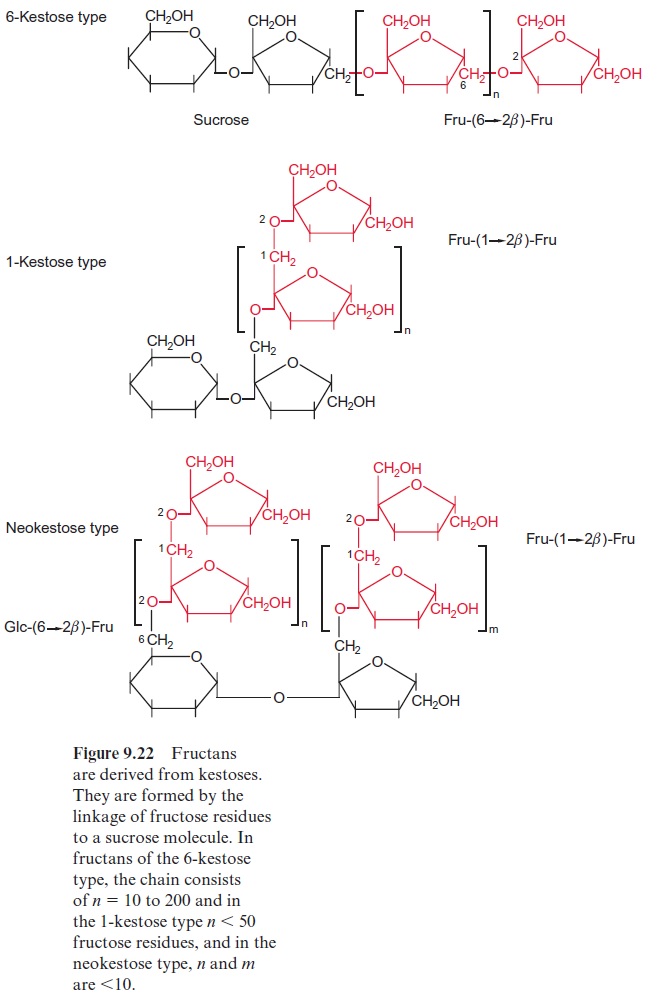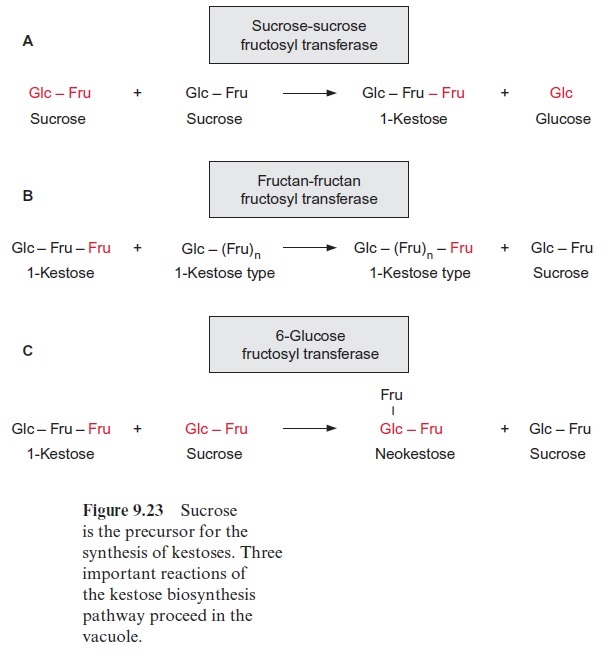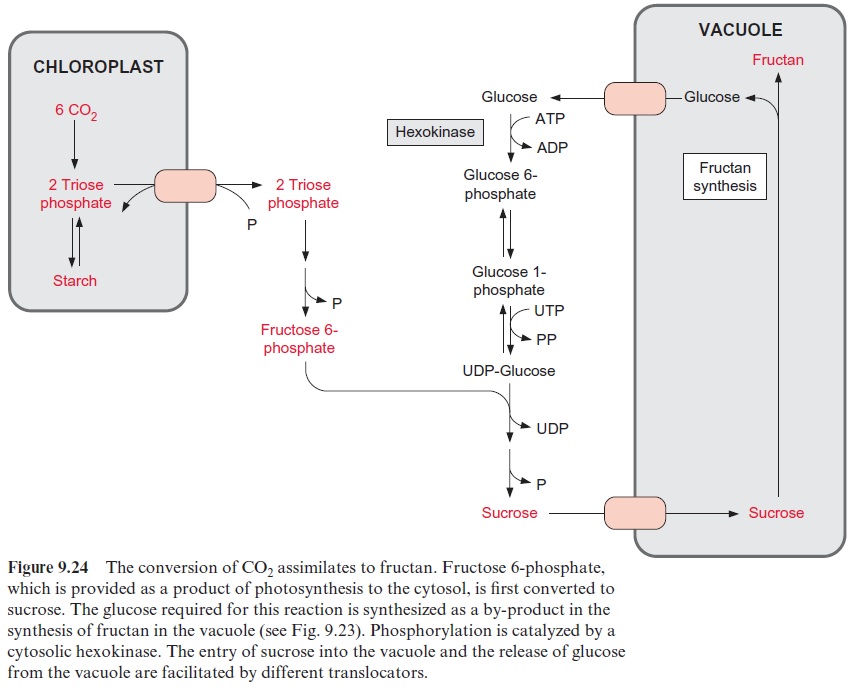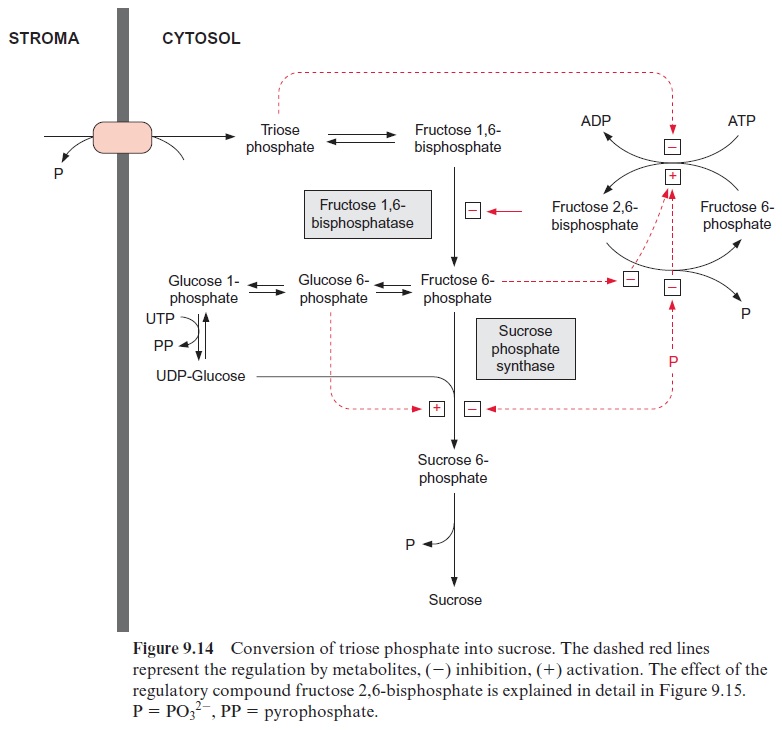Chapter: Plant Biochemistry: Polysaccharides are storage and transport forms of carbohydrates produced by photosynthesis
Fructans are deposited as storage compounds in the vacuole
Fructans are deposited as storage compounds in the vacuole
In addition to starch, many plants use fructans as carbohydrate storage compounds. Whereas starch is an insoluble polyglucose formed in the plas-tids, fructans are soluble polyfructoses that are synthesized and stored in the vacuole. They were first detected in the tubers of ornamental flowers such as dahlias. Fructans are stored, often in the leaves and stems, of many grasses from temperate climates, such as wheat and barley. Fructans are also the major carbohydrate present in onions and, like the raffinose sug-ars, cannot be digested by humans. Because of their sweet taste, fructans are used as natural calorie-free sweeteners. Fructans are also used in the food industry as a replacement for fat.
The precursor for the polysaccharide chain of fructans is a sucrose mol-ecule to which additional fructose molecules are attached by glycosidic linkages. The basic structure of a fructan in which sucrose is linked with one additional fructose molecule to a trisaccharide is called kestose. Figure 9.22 shows three major types of fructans.

In fructans of the 6-kestose type, the fructose residue of sucrose is gly-cosidically linked at position 6 with the 2β -position of another fructose. Chains of different lengths (10–200 fructose residues) are elongated by (6→2β )-linkages of additional fructose residues. These fructans are also called levan type fructans and are often found in grasses.
The fructose residues in fructans of the 1-kestose type are linked to the sucrose molecule by (1→2β ) glycosidic linkages. These fructans, also called inulin type fructans, consist of up to 50 fructose molecules. Inulin is found in dahlia tubers.
In fructans of the neokestose type, two polyfructose chains are con-nected to the fructose moiety of sucrose, one via (1→2β ) glycosidic link-age, and the other in a (6→2β ) glycosidic linkage with the glucose residue of the sucrose molecule. The fructans of the neokestose type are comprised of only 5 to 10 fructose residues. Branched fructans in which the fructose molecules are connected by both (1→2β )- and (6→2β )-glycosidic linkages are found in wheat and barley and are called graminanes.

Although fructans appear to have an important function in the metab-olism of many plants, our knowledge of their function and metabolism is still fragmentary. Fructan synthesis occurs in the vacuoles, and sucrose is the precursor for its synthesis. The fructose moiety of a sucrose molecule is transferred by a sucrose-sucrose fructosyl transferase to a second sucrose molecule, resulting in the formation of a 1-kestose with a glucose molecule remaining (Fig. 9.23A). Additional fructose residues are transferred not from another sucrose molecule but from another kestose molecule for the elongation of the kestose chain (Fig. 9.23B). The enzymefructan-fructan 1-fructosyl transferase transfers preferentially the fructose residue from a trisaccharide to a longer chain kestose. Correspondingly, the forma-tion of 6-kestoses is catalyzed by a fructan-fructan 6-fructosyl transferase. For the formation of neokestoses, a fructose residue is transferred via a 6-glucose-fructosyl transferase from a 1-kestose to the glucose residue of sucrose (Fig. 9.23C). The trisaccharide thus formed is a precursor for fur-ther chain elongation as shown in Figure 9.23B.
The degradation of fructans proceeds by successive hydrolysis of fruc-tose residues from the end of the fructan chain which is catalyzed by exo-hydrolytic enzymes. In many grasses, fructans accumulate for a certain time in the leaves and in the stems, and then constitute up to 30% of the dry matter. Often these carbohydrates accumulate before the onset of flowering and are available for rapid seed growth after pollination of the flowers. In plants growing in meager habitats, where periods of high photosynthesis are succeeded by periods with limited and inadequate photosynthesis, fructans are a reserve for surviving unfavorable conditions. Thus in many plants fructans are formed when these are subjected to water or cold stress.

Plants that accumulate fructans usually also store sucrose and starch in their leaves. Figure 9.24 shows a simplified scheme of fructan synthesis as an alternative storage compound in leaves. For the synthesis of fructans, sucrose is first synthesized in the cytosol (seeFigure 9.14 for details). The UDP-glucose required is synthesized from glucose that is released from the vacuole in the course of fructan synthesis and subsequently phosphorylated by hexokinase. Fructose 6-phosphate, generated by photosynthesis and UDP-glucose, is converted into fructan, which requires altogether two ATP equivalents per molecule of fructan.

The large size of the leaf vacuoles, often comprising about 80% of the total cellular volume, provides the plant with a very advantageous storage capacity for carbohydrates in the form of fructans. Thus, in leaves, on top of the diurnal carbohydrate stores such as transitory starch and sucrose, an additional carbohydrate reserve is maintained to serve purposes such as rapid seed production or endurance of unfavorable growth conditions.
Related Topics